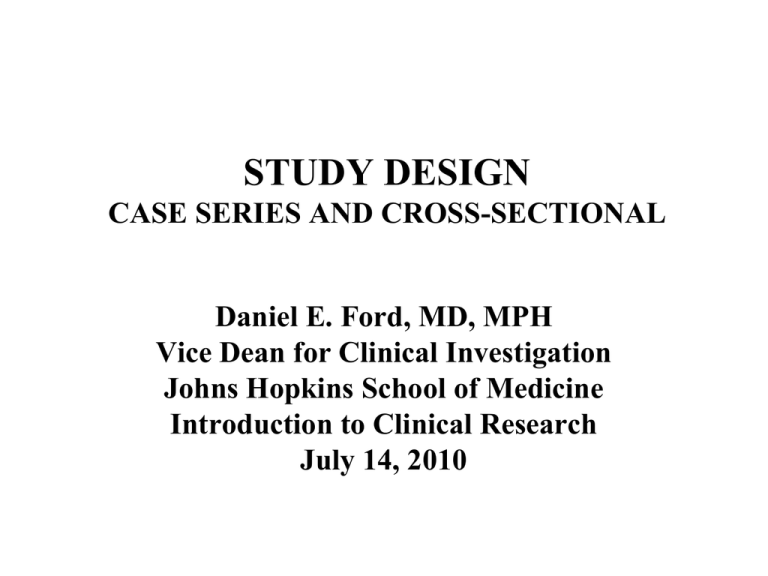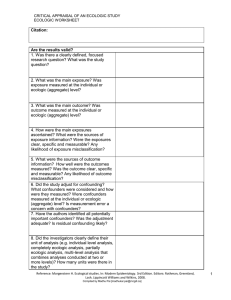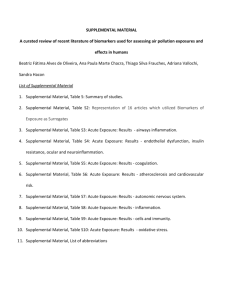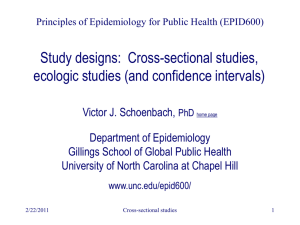
STUDY DESIGN
CASE SERIES AND CROSS-SECTIONAL
Daniel E. Ford, MD, MPH
Vice Dean for Clinical Investigation
Johns Hopkins School of Medicine
Introduction to Clinical Research
July 14, 2010
STUDY DESIGN
• Provides “differential diagnosis” of a study’s
strengths and weakness
• Determines confidence in results of study
• Facilitates critical appraisal of the medical
literature
• Linked to research question
STUDY DESIGNS AND
CORRESPONDING QUESTIONS
• Ecologic
•
•
•
•
•
• What explains differences
between groups?
Case Series
• How common is this finding
in a disease?
Cross-sectional
• How common is this disease
or condition?
Case-control
• What factors are associated
with having a disease?
Prospective
• How many people will get the disease?
What factors predict development?
Randomized trial If we change something does the
outcome change
2 x 2 TABLE
Disease Status
(Outcome)
Risk Factor
(Exposure)
Yes
No
Total
Yes
A
B
A+B
No
C
D
C+D
A+C
B+D
Total
Relative Risk = (A/A + B)
(C/C + D)
Odds Ratio = AD
BC
STUDY DESIGN
DEFINITIONS
• Based on sampling strategy, i.e., how we
choose who gets into the study
• Sampling with regard to disease: crosssectional and case-control studies
• Sampling with regard to exposure or
treatment: prospective studies
CRITERIA FOR CAUSAL
INFERENCE
•
•
•
•
•
•
•
•
•
Experimental evidence
Temporality
Strength of the association
Dose-response relationship
Consistency in different populations
Specificity: exposure leads to only 1 disease
Biologic plausibility
Coherence
Analogy
Not all study designs are
created equal!
HIERARCHY OF STUDY
DESIGNS
RCTs
Prospective
Studies
Case-control Studies
Cross-sectional Studies
Ecologic Studies
STUDY DESIGN
EXAMPLE
• Does higher dose of dialysis (Kt/v) result
in lower mortality in hemodialysis
patients?
ECOLOGIC STUDIES
• Sometimes called correlational studies
• Compares outcomes between groups, not
individuals
• Useful to examine trends over time or to
explain differences between groups
2 x 2 Table
Outcome
Exposure
Total
Yes
No
Total
Yes
a
b
a+b
No
c
d
c+ d
a+c
b+d
N
Letters represent group rates or means, not individuals
Exposure can be assessed before or after outcome
Kt/V AND MORTALITY
IN 100 DIALYSIS UNITS
Mean Clinic
Kt/V
Mortality
High
Low
Acceptable
20
40
Low
20
40
20
60
VITAL STATISTICS
• Common data source for ecologic studies
• Describes disease patterns in entire geographic
or political populations
• Routinely collected information from birth and
death certificates; allow comparisons between
countries over time
• Comparison by age, race, sex, geographic areas
and time period
VITAL STATISTICS
ADVANTAGES
• Inexpensive
• Representative of large groups and large
geographic areas
• Available over long periods of time
• Uniform coding rules
VITAL STATISTICS
DISADVANTAGES
•
•
•
•
•
•
Group “ecologic” data -- not individual
Uncertain accuracy of diagnoses
Changes in ICD codes
Variability in coding practices
Limited to available data
Mortality may not reflect incidence
ECOLOGIC STUDIES
DISADVANTAGES
• Subject to ecologic fallacy
• Lead to unusual conclusions if not testing
biologically plausible hypotheses
• Usually done early in the investigation of
a research question when cohort studies
or clinical trials not available
STUDY DESIGNS AND
CORRESPONDING QUESTIONS
• Ecologic
• Case Series
• Cross-sectional
• Case-control
• Prospective
• What explains differences
between groups?
• How common is this finding
in a disease?
• How common is this disease
or condition?
• What factors are associated
with having a disease?
• How many people will get the disease?
What factors predict development?
CASE REPORTS
• Make observations about medical
phenomena in an individual patient
• Simple description of clinical data
without comparison group
• Observations should be comprehensive
and adequately detailed
Kt/V AND MORTALITY
CASE REPORT
• 55 year old man has been on dialysis for
35 years
• On home dialysis daily during that time
• No evidence of hypertension,
cardiovascular disease, LVH
CASE REPORTS
ADVANTAGES
• Easy and inexpensive to do in hospital
• Provides information on new disease or
new therapy
• Useful in conveying “clinical experience”
• Helpful in hypothesis formation
CASE REPORTS
DISADVANTAGES
• Biased selection of subjects so that
conclusions are difficult to generalize
• Were the findings a chance happening or
characteristic of the disease?
• Is the “exposure” really higher than a
comparison group?
CASE REPORTS
EXAMPLES
• Asbestos and mesothelioma
• Pneumocystis pneumonia
• Legionnaire’s Disease
DECIDING TO PUBLISH
• What observations have been made prior
to this report?
• What new phenomenon is illustrated?
• What further studies should be done?
CASE SERIES
• Group of patients with a disease or
outcome
• Usually consecutive series
• Detailed observations
• No comparison group – difficult to
address etiologic questions
2 x 2 TABLE
Case Series
O utcom e
Y es
No
E xposure Y es
No
T otal
a
c
a +c
T otal
a
c
N
DISTRIBUTION OF Kt/V IN
100 PATIENTS WHO DIED DURING THE
FIRST YEAR OF DIALYSIS
N = 100
•
L ow K t/V
70%
A cceptable
K t/V
30%
review records on 100 patients who died
CASE SERIES
OBSERVATIONS
• Should have clear definitions of the
phenomena being studied
• These same definitions should be applied
equally to all individuals in the series
• All observations should be reliable and
reproducible (consider blinding)
CASE SERIES
PRESENTATION OF
FINDINGS
• Proportions (% per 105, etc.) of the study
populations with the outcome, confidence
intervals
• Means, standard errors for continuous
variables
• Are there important subgroups that need
data presented separately?
CASE SERIES
ADVANTAGES
• Informs patients and physicians about
natural history and prognostic factors
• Easy and inexpensive to do in hospital
settings
• Helpful in hypothesis formation
CASE SERIES
LIMITATIONS
• Cases may not be representative
• Outcome may be a chance finding,
not characteristic of disease
• Cannot easily examine disease
etiology
• Exposure reflects the underlying
population, not the outcome
• Begs the question “Compared to
what?”
STUDY DESIGNS AND
CORRESPONDING QUESTIONS
• Ecologic
• Case Series
• Cross-sectional
• Case-control
• Prospective
• What explains differences
between groups?
• How common is this finding
in a disease?
• How common is this disease
or condition?
• What factors are associated
with having a disease?
• How many people will get the disease?
What factors predict development?
CROSS-SECTIONAL STUDIES
• Make observations concerning the
prevalence and characteristics of a
disease in a well-defined population over
a defined period of time (period
prevalence)
• Estimate prevalence
• Examine characteristics associated with
condition or disease by comparing cases
to noncases
CROSS-SECTIONAL STUDIES
DESIGN
non-cases
cases
2 x 2 TABLE
Cross-sectional Study
D isease
E xposure
T otal
Y es
No
Y es
No
T otal
a
c
b
d
a+ b
c+ d
a+ c
b+ d
N
D raw a 1% random sam ple of all hem odialysis patients dialyzed in
1996
A ssess K t/V in all patients and their vital status at the end of 1996
PREVALENCE OF LOW Kt/V AND MORTALITY
DECEMBER 31, 1996
D ead
A live
T o tal
L o w K t/V
40 0
1 ,0 00
1 ,4 00
H igh K t/V
35 0
1 ,2 50
1 ,6 00
75 0
2 ,2 50
3 ,0 00
O dd s R atio = (4 00 ) (1,250 ) = 1.4
(350 ) (1 ,00 0)
MEAN BLOOD PRESSURE BY AGE AND
GENDER, U.S., 1991
Burt, Hypertension, 1995
Number of Medicare ESRD Patients
on Dialysis in the United States
350,000
250,000
200,000
150,000
100,000
50,000
Year
95
19
93
19
91
19
89
19
87
19
85
19
83
19
81
19
79
19
77
0
19
ESRD Patients
300,000
SAMPLING
• Process of obtaining a sample of a
population for study
• In clinical research, goal should always
be a representative sample
• Variety of methods available
CROSS-SECTIONAL STUDIES
SAMPLING THE POPULATION
• Derive a sampling “frame”
• Choose a sampling strategy
• Maximize response rate
CROSS-SECTIONAL STUDIES
TYPES OF SAMPLING
• Simple random--each individual has the same
probability of being chosen
• Stratified random--if most variance is between
strata, gives lower sampling variance
• Systematic—used commonly in clinical
research, akin to stratified random sample if
list is ordered
• Cluster
RESPONSE RATES AND
SAMPLING
• Sample size of 500
– 5% of 10,000=500
– 75% of 666=500
• Which study provides the most valid
causal inference?
• Are persons who do not respond (can’t be
found or say no) likely to be different
than those who do?
NONRESPONSE IN SAMPLING
CROSS SECTIONAL STUDIES
• Minimize non-response
– smaller sample size allows more intensive
recruitment
– collect data on non-responders, if possible
– intensively recruit a sub-sample of nonresponders
CROSS-SECTIONAL STUDIES
ADVANTAGES
• Inexpensive for common diseases
• Should be able to get a better response
rate than other study designs
• Relatively short study duration
• Can be addressed to specific populations
of interest
CROSS-SECTIONAL STUDIES
DISADVANTAGES
• Unsuitable for rare or short duration diseases
(prevalence = incidence x duration)
• High refusal rate may make accurate
prevalence estimates impossible
• More expensive and time consuming than casecontrol studies
• Disease process may alter exposure
• No data on temporal relationship between risk
factors and disease development
Defining Cross-Sectional Studies
• How short is the assessment period?
– Symptom questionnaire and then physical
exam
• Cases accumulated over long period of
time
• Time trends of multiple cross-sectional
studies (smoking rates in population over
time)
STUDY DESIGNS AND
CORRESPONDING QUESTIONS
• Ecologic
• Case Series
• Cross-sectional
• Case-control
• Prospective
• What explains differences
between groups?
• How common is this finding
in a disease?
• How common is this disease
or condition?
• What factors are associated
with having a disease?
• How many people will get the disease?
What factors predict development?












